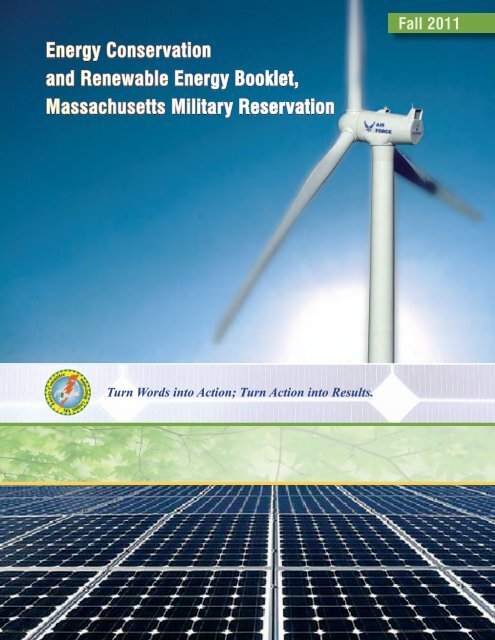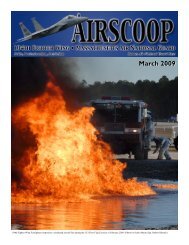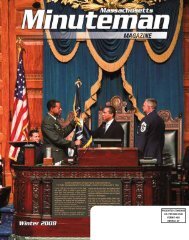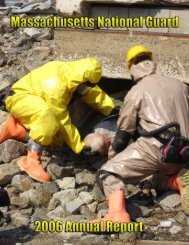Energy Conservation and Renewable Energy Booklet ... - STATES
Energy Conservation and Renewable Energy Booklet ... - STATES
Energy Conservation and Renewable Energy Booklet ... - STATES
Create successful ePaper yourself
Turn your PDF publications into a flip-book with our unique Google optimized e-Paper software.
<strong>Energy</strong> <strong>Conservation</strong><br />
<strong>and</strong> <strong>Renewable</strong> <strong>Energy</strong> <strong>Booklet</strong>,<br />
Massachusetts Military Reservation<br />
Turn Words into Action; Turn Action into Results.<br />
Fall 2011
<strong>Energy</strong> <strong>Conservation</strong> <strong>and</strong> <strong>Renewable</strong> <strong>Energy</strong> <strong>Booklet</strong>, Massachusetts Military Reservation<br />
The Massachusetts Military Reservation<br />
<strong>Energy</strong> Committee<br />
The Massachusetts Military Reservation (MMR) <strong>Energy</strong> Committee was formed in 2007 to facilitate<br />
energy conservation <strong>and</strong> use of renewable energy technologies in order to reduce operational costs<br />
<strong>and</strong> minimize the carbon bootprint. The committee’s goals include increasing energy awareness<br />
through education; helping to meet the intent of Executive Order 13514; <strong>and</strong> advising the Joint<br />
Oversight Group (the MMR Comm<strong>and</strong>ers) on matters related to the MMR <strong>Energy</strong> Policy. The<br />
committee was established to oversee a reduced impact on the environment, the reduction of costs<br />
associated with energy use, the reduction of dependence on foreign oil, <strong>and</strong> to review renewable<br />
energy projects proposed for the MMR.<br />
The committee meets periodically on topics ranging from the Cape Light Compact, NStar <strong>and</strong><br />
National Grid, to energy policy, potential energy-related projects for MMR, <strong>and</strong> energy activity<br />
discussions between MMR agencies.<br />
More information about the <strong>Energy</strong> Committee is available at:<br />
http://states.ng.mil/sites/MA/MMR/energy-committee.htm<br />
Fall 2011<br />
Wind turbines in northern MMR<br />
2<br />
Proposed solar PV site at L<strong>and</strong>fill 1<br />
Irrigation pumps - treated effluent
<strong>Energy</strong> <strong>Conservation</strong> <strong>and</strong> <strong>Renewable</strong> <strong>Energy</strong> <strong>Booklet</strong>, Massachusetts Military Reservation<br />
Our Mission<br />
The purpose of the MMR <strong>Energy</strong> Committee is to facilitate energy conservation<br />
<strong>and</strong> use of renewable energy technologies in order to reduce operational costs<br />
<strong>and</strong> minimize the carbon bootprint. Goals include increasing energy awareness<br />
through education; help meet the intent of Executive Order 13514; <strong>and</strong> advise the<br />
Joint Oversight Group on matters related to the MMR <strong>Energy</strong> Policy.<br />
The <strong>Energy</strong> Committee is comprised of representatives from the major military comm<strong>and</strong>s on MMR:<br />
US Coast Guard • 6th Space Warning Squadron • Air National Guard 102nd Intelligence Wing<br />
<strong>and</strong> the Army National Guard • Camp Edwards • Massachusetts National Guard Environmental &<br />
Readiness Center • Army Environmental Comm<strong>and</strong>’s Impact Area Groundwater Study Program • Air<br />
Force Center for Engineering <strong>and</strong> the Environment’s Installation Restoration Program • Veteran’s<br />
Affairs Cemetery • US Department of Agriculture • MassDevelopment • Environmental Management<br />
Commission • Senior Environmental Corps • MassCEC.<br />
<strong>Energy</strong> Projects at MMR:<br />
• AFCEE constructed three 1.5 MW wind turbines PAVE PAWS is planning<br />
for the installation of two additional utility scale turbines.<br />
• The MMR is considering the installation of solar panel arrays on the l<strong>and</strong>fill.<br />
• The VA cemetery installed a 50 KW wind turbine on their property.<br />
• USCG uses a geothermal heating/cooling system at one of its hangars <strong>and</strong><br />
is incorporating geothermal in a new hangar construction project.<br />
• The various MMR agencies are actively making improvements in energy<br />
efficiency including programs offered by Cape Light Compact.<br />
• New building construction is LEED silver at a minimum.<br />
General information about the MMR is available at: http://www.mmr-info.org/<br />
More information about the <strong>Energy</strong> Committee is available at:<br />
http://states.ng.mil/sites/MA/MMR/energy-committee.htm<br />
3<br />
Fall 2011
<strong>Energy</strong> <strong>Conservation</strong> <strong>and</strong> <strong>Renewable</strong> <strong>Energy</strong> <strong>Booklet</strong>, Massachusetts Military Reservation<br />
The Air Force Center for Engineering <strong>and</strong> the Environment<br />
The Air Force Center for Engineering <strong>and</strong> the Environment (AFCEE) manages<br />
the Installation Restoration Program (IRP) at the Massachusetts Military<br />
Reservation (MMR). To address the groundwater contamination, AFCEE<br />
constructed nine treatment plants that at one time treated approximately<br />
18 million gallons per day (MGD) of contaminated groundwater containing<br />
chlorinated solvents <strong>and</strong>/or fuel-related compounds. Through optimization <strong>and</strong><br />
plume remediation, AFCEE is currently treating 10.3 MGD. The treatment<br />
systems are energy intensive <strong>and</strong> have an environmental impact due to the use<br />
of fossil-fuel based electric power to run the treatment plants. Annual energy<br />
costs range from $1.5-2.0 million <strong>and</strong> over thous<strong>and</strong>s of tons of air emissions,<br />
such as carbon dioxide, nitrogen oxide <strong>and</strong> sulfur dioxide, are produced each<br />
year to generate the power.<br />
4<br />
new<br />
photo<br />
To reduce the electricity costs <strong>and</strong> environmental footprint of the IRP, AFCEE<br />
has implemented a robust optimization program including energy conservation<br />
<strong>and</strong> renewable energy technology.<br />
Optimization activities related to the pump <strong>and</strong> treat systems <strong>and</strong> wellfield<br />
include:<br />
Variable Frequency Drive<br />
- optimizing flow rates in extraction wells including turning wells off, pulse pumping wells, <strong>and</strong> packering the well<br />
screens<br />
- evaluating in situ technologies <strong>and</strong> natural attenuation in place of pump <strong>and</strong> treat<br />
- conducting life cycle assessments on pumps <strong>and</strong> motors <strong>and</strong> replacing them as they age <strong>and</strong> become less efficient<br />
- turning off booster pumps in treatment plants as flow decreases <strong>and</strong> removing the impellers to reduce friction (i.e.<br />
energy) losses<br />
- installing variable frequency drives to extend lifetimes of pump/motor assemblies <strong>and</strong> to make them more efficient<br />
- conducting energy audits <strong>and</strong> replacing inefficient sodium vapor overhead lighting with high efficiency fluorescent<br />
lighting<br />
- reusing treated water for irrigation <strong>and</strong> evaluating it for use in HVAC geothermal applications.<br />
Fall 2011
<strong>Energy</strong> <strong>Conservation</strong> <strong>and</strong> <strong>Renewable</strong> <strong>Energy</strong> <strong>Booklet</strong>, Massachusetts Military Reservation<br />
In the IRP, thous<strong>and</strong>s of wells have been sampled <strong>and</strong> hundreds of direct push locations have been drilled. In order to<br />
reduce the environmental impact of these activities, AFCEE:<br />
- switched from low flow pumping to using passive diffusion bags for VOCs <strong>and</strong> Hydrasleeves for metals in over 90%<br />
of monitoring wells.<br />
- continuously optimizes the monitoring well network to include reduction in sampling frequency, the number of<br />
locations, <strong>and</strong> the number of analytes.<br />
AFCEE self-performs direct push work using the smaller footprint Geoprobe 6620DT for conducting data gap sampling<br />
<strong>and</strong> installing monitoring wells. Environmentally friendly fuels such as biodiesel <strong>and</strong> soy-based hydraulic fluid are used<br />
in the Geoprobe.<br />
The IRP uses granular activated carbon (GAC) in the pump <strong>and</strong> treat systems to remove the contamination from the<br />
groundwater. Several optimization activities have been conducted by AFCEE/MMR to reduce carbon costs, extend the<br />
life of the carbon, <strong>and</strong> operate the carbon treatment in the most sustainable manner:<br />
- using reactivated GAC instead of virgin material<br />
- evaluating alternative GACs to determine the most efficient product for our situation<br />
- evaluating pretreatment of the influent using an oxidizer to extend the life of carbon<br />
- evaluating on site regeneration of the GAC using two different technologies: (1) microwave technology, <strong>and</strong> (2) hot<br />
water desorption followed by advanced oxidation<br />
AFCEE has also conducted energy audits of the facilities <strong>and</strong> replaced inefficient lighting <strong>and</strong> windows, installed<br />
occupancy sensors, programmable thermostats, <strong>and</strong> LED exit lights. The geothermal content of the groundwater is<br />
used to heat the treatment plants.<br />
AFCEE/MMR enrolled 860 kW in the <strong>Energy</strong> Dem<strong>and</strong> Response program <strong>and</strong> also evaluates utility rate structures to<br />
ensure accounts are on the most appropriate rate plan.<br />
AFCEE has also evaluated renewable energy to offset the electric cost <strong>and</strong> impacts from air emissions associated with<br />
the power sources for the pump <strong>and</strong> treat systems. In 2009, AFCEE installed a $4.6M 1.5 MW Fuhrlaender wind turbine<br />
(Wind I). Since startup on Dec. 2, 2009 through the end of June 2011, Wind I saved the taxpayer over $600,000 <strong>and</strong><br />
eliminated tons of carbon dioxide <strong>and</strong> other air emissions from being generated. Due to the success of Wind I, AFCEE<br />
developed Wind II, two 1.5 MW General Electric wind turbines. A construction contract was awarded in September<br />
2009 for $9.4 million <strong>and</strong> the two turbines were installed during Summer 2011. Wind II is expected to be operational in<br />
Fall 2011. The combination of Wind I <strong>and</strong> Wind II is anticipated to offset electrical use <strong>and</strong> air emissions by nearly 100%<br />
within the next five years.<br />
5<br />
Fall 2011
<strong>Energy</strong> <strong>Conservation</strong> <strong>and</strong> <strong>Renewable</strong> <strong>Energy</strong> <strong>Booklet</strong>, Massachusetts Military Reservation<br />
The U.S. Department of Agriculture (USDA), Animal <strong>and</strong> Plant Health Inspection Service (APHIS) safeguards the<br />
nation’s agricultural <strong>and</strong> natural resources from invasions of foreign pest organisms. This APHIS facility, Otis Pest<br />
Survey Detection <strong>and</strong> Exclusion Laboratory, provides operational support for national efforts to exclude <strong>and</strong> detect<br />
introductions of exotic pests. The laboratory also provides support for the control of pests, such as the<br />
emerald ash borer, Sirex wood wasp, Asian longhorned beetle, Asian gypsy moth,<strong>and</strong> offshore<br />
port monitoring programs.<br />
The USDA has initiated several energy saving projects/initiatives over the last few<br />
years, the most important of these is a major renovation project currently underway<br />
in Building 1398. While this project is a Life Safety upgrade project, we are also<br />
installing a new energy efficient boiler for the building <strong>and</strong> replacing the existing one<br />
zone HVAC system with a system that will utilize Direct Digital Control (DDC) zone<br />
controls <strong>and</strong> an ERU (<strong>Energy</strong> Recovery Unit) for all of the fume hoods in the building.<br />
The facility has also had an energy audit performed in recent<br />
years, <strong>and</strong> as a result of this audit, has retrofitted all of the<br />
lighting fixtures to T-8 fixtures.<br />
The USDA is also constructing a new facility that will be built following Leadership in <strong>Energy</strong> <strong>and</strong> Environmental Design<br />
(LEED) Silver guidelines.<br />
Future projects include upgrading the existing windows <strong>and</strong> replacing existing refrigeration units with more efficient<br />
units. As a support research laboratory for APHIS one of our unit charges is to develop more efficient <strong>and</strong> cost effective<br />
technology for safeguarding our agricultural <strong>and</strong> nature systems.<br />
Fall 2011<br />
U.S. Department of Agriculture<br />
Asian longhorned beetle<br />
6<br />
Sirex wood wasp<br />
Asian gypsy moth
<strong>Energy</strong> <strong>Conservation</strong> <strong>and</strong> <strong>Renewable</strong> <strong>Energy</strong> <strong>Booklet</strong>, Massachusetts Military Reservation<br />
U.S. Coast Guard Air Station Cape Cod<br />
U.S. Coast Guard Air Station Cape Cod (ASCC),<br />
with its four helicopters <strong>and</strong> four jets, is the only<br />
Coast Guard Aviation facility in the northeast. As<br />
such, ASCC is responsible for the waters from New<br />
Jersey to the Canadian border. Centrally located at<br />
the Massachusetts Military Reservation on Cape Cod,<br />
ASCC maintains the ability to launch a helicopter <strong>and</strong>/<br />
or jet within 30 minutes of a call, 365 days-a-year, 24<br />
hours-a-day, <strong>and</strong> in nearly any weather conditions.<br />
Our mission is to protect life, property <strong>and</strong> the marine<br />
environment in service to the public <strong>and</strong> our country.<br />
Average annual energy costs to support ASCC is $2.4<br />
million for natural gas <strong>and</strong> electricity combined <strong>and</strong><br />
over thous<strong>and</strong>s of tons of air emissions are produced<br />
each year from these power sources. To reduce the<br />
energy costs <strong>and</strong> environmental impact, ASCC has<br />
implemented several conservation strategies <strong>and</strong><br />
utilizes green energy technology.<br />
Air Station Cape Cod Airfield<br />
In June 2009, ASCC signed agreements with Cape Light Compact, an inter-municipal energy service organization that<br />
is funded by all consumers of electricity on Cape Cod <strong>and</strong> Martha’s Vineyard. The purpose of the venture was to make<br />
the existing Coast Guard infrastructure more energy efficient. Since then, Cape Light Compact has worked to re-lamp<br />
<strong>and</strong> re-ballast lighting fixtures <strong>and</strong> exit signs, install occupancy sensors, <strong>and</strong> upgrade refrigeration units in 34 buildings.<br />
The partnership will be finalized by the close of 2012, which will result in a total estimated savings of $200,000 for<br />
project costs <strong>and</strong> $80,000 on ASCC’s annual electric bill.<br />
ASCC is enrolled in the <strong>Energy</strong> Dem<strong>and</strong> Response program in Massachusetts.<br />
Participants in this program are paid to curtail load during peak grid use. ASCC<br />
is enrolled for 100 kilowatt (kW) with plans to add to the curtailment load. In 2010<br />
a comprehensive <strong>Energy</strong> Assessment Survey was conducted. Based on the<br />
assessment a number of optimization <strong>and</strong> energy conservation measures are<br />
planned for implementation. ASCC provides the energy conservation portion of the<br />
annual environmental fair held on the MMR for local school children.<br />
In addition to energy conservation <strong>and</strong> dem<strong>and</strong> response, ASCC has installed green energy technology in two aircraft<br />
hangers. In 2004, ASCC installed a geothermal system in the aircraft ready hanger. Not interconnected directly to the<br />
grid; rather the geothermal system is used inside the hangar as an HVAC system. The system offsets energy use in<br />
place of a 60 ton air conditioning system. Plans for similar system are underway for use in the Maritime Patrol Aircraft<br />
(MPA) hanger, which is currently under construction. The new geothermal system is expected to be operational in 2012.<br />
The LEED Silver certification of the MPA hanger deems a 75% total energy cost savings over the ASHRAE 90.1-2007<br />
Baseline design.<br />
ASCC runs a robust recycling program, taking in paper, cardboard, newspapers, magazines, glass, plastic, tin, metal,<br />
wood, electronic waste, batteries, waste oil, JP-8, light bulbs, cooking grease/oil, food waste, tires, <strong>and</strong> household<br />
hazardous waste generated by employees <strong>and</strong> residents living on base. Each year this program removes approx 300<br />
tons of material from the solid waste stream that would typically go to l<strong>and</strong>fills, <strong>and</strong> re-directs the material into recycled<br />
resources. Partnering with the Town of Bourne, the Coast Guard avoids costly tipping <strong>and</strong> disposal fees normally<br />
associated with on-base trash removal.<br />
ASCC also requires contractors to purchase green products when available, to recycle, <strong>and</strong> to source products <strong>and</strong><br />
subcontractors locally.<br />
7<br />
Fall 2011
<strong>Energy</strong> <strong>Conservation</strong> <strong>and</strong> <strong>Renewable</strong> <strong>Energy</strong> <strong>Booklet</strong>, Massachusetts Military Reservation<br />
102nd Intelligence Wing, Otis Air National Guard Base<br />
Think Green, Build Green, Fly Blue<br />
In accordance with the Air Force <strong>and</strong> Air National Guard <strong>Energy</strong> goals <strong>and</strong> objectives the 102nd Intelligence Wing<br />
is committed to reduce dem<strong>and</strong>, increase supply, <strong>and</strong> affect a culture change within the organization to improve our<br />
energy footprint.<br />
The 102nd has implemented a<br />
number of initiates to reduce energy<br />
consumption. How we save, conserve,<br />
<strong>and</strong> efficiently use energy has a direct<br />
impact on our mission here at Otis<br />
Air National Guard Base. We have<br />
changed the way we design, construct,<br />
<strong>and</strong> operate our buildings. For many<br />
years our Wing leadership has been a<br />
strong proponent of recycling initiatives<br />
that have exp<strong>and</strong>ed to include paper,<br />
cardboard, metals <strong>and</strong> construction<br />
materials. Since 2007 the Air Force<br />
has required compliance with LEED<br />
st<strong>and</strong>ards. Currently the 102nd has<br />
one building in design <strong>and</strong> close to<br />
70,000 square feet of facilities under<br />
construction on track to receive Silver<br />
certification in the LEED program. This<br />
includes a Distributed Ground Station<br />
(DGS) facility that will be the first of<br />
its kind in the Air Force to receive any<br />
level of certification.<br />
We are exploring renewable energy opportunities with a potential solar array at the old l<strong>and</strong>fill site that could provide<br />
up to 12 megawatts (MW) of clean renewable power. In addition we have contracted for the study <strong>and</strong> design of a<br />
geothermal project that could service the majority of our new campus area. We have recently completed a level II<br />
<strong>Energy</strong> Audit on all of our facilities that will assist us in programming projects <strong>and</strong> programs to achieve both short <strong>and</strong><br />
long term goals. Some of these include replacing lower efficiency boilers <strong>and</strong> optimizing their scheduling, applying<br />
dem<strong>and</strong> control ventilation, <strong>and</strong> the retrofit of lighting <strong>and</strong> controls.<br />
In 2011 alone the 102nd has reduced its facility square footage by nearly 100,000 square feet of space, including the<br />
demolition of 19 buildings, <strong>and</strong> our entire Petroleum, Oils, Lubricants (POL) facility with over 1 million gallons of fuel<br />
capacity. This footprint reduction will greatly enhance our ability to optimize our energy performance by economizing<br />
space <strong>and</strong> replacing old antiquated structures with new, state of the art, energy efficient facilities.<br />
We recently removed almost 8 acres of impervious pavements. This material is recycled locally, reduces runoff<br />
<strong>and</strong> pollution, <strong>and</strong> allows for more natural drainage. This reduces maintenance <strong>and</strong> subsequently reduces energy<br />
consumption.<br />
Fall 2011<br />
8
<strong>Energy</strong> <strong>Conservation</strong> <strong>and</strong> <strong>Renewable</strong> <strong>Energy</strong> <strong>Booklet</strong>, Massachusetts Military Reservation<br />
6th Space Warning Squadron<br />
The 6th Space Warning Squadron (6 SWS) is one of the largest single<br />
users of electricity on Cape Cod. For Fiscal Year (FY) 2010, we consumed<br />
approximately two million kilowatt hours (KWH) of electricity at a cost of<br />
just under $2 million, averaging $5,100 per day. We’ve been working hard<br />
to reduce energy consumption <strong>and</strong> costs through several initiatives.<br />
Electricity Contracts: We purchase our electricity supply through the<br />
Defense Logistics Agency <strong>Energy</strong>. As part of a regionally competed<br />
contract, we are able to receive our electricity at a much lower rate than the<br />
local utility company can offer. Since January 2010, our new contract price<br />
reduced the supply cost by just under $0.02 per KWH or approximately<br />
$40,000 per year.<br />
Cape Light Compact (CLC): The CLC works with our local utility<br />
provider to manage energy conservation projects for Cape Cod. They<br />
have conducted energy audits of our site <strong>and</strong> have funded a project to<br />
replace lights, motors, <strong>and</strong> install variable frequency drives on many of<br />
our systems including the array chilled water supply. So far, they have<br />
funded over $300,000 at no additional cost to the Air Force. The project is<br />
expected to save over $150,000 annually. They are currently reviewing<br />
our Satellite Communications facility to see if additional energy savings<br />
could be generated by improving its energy efficiency.<br />
Operators monitor consoles for missile warning <strong>and</strong> space<br />
surveillance at Cape Cod Air Force Station, 2011<br />
Chiller Replacement Project: We awarded a project to replace<br />
our two, 450 ton chillers with new units that include variable<br />
frequency drives, direct digital controls, <strong>and</strong> a plate <strong>and</strong> frame<br />
heat exchanger. The first of the new chillers is already installed<br />
<strong>and</strong> undergoing its testing period. Installation of the second<br />
chiller, which got underway in October 2011, should be complete<br />
in early 2012. Ultimately, replacing our chillers could yield energy<br />
savings of approximately $100,000 per year.<br />
Construction of Two Wind Turbines:<br />
We are working with Air Force<br />
Space Comm<strong>and</strong> <strong>and</strong> the Air Force<br />
Civil Engineering Support Agency<br />
(AFCESA) to construct two 1.5<br />
megawatt (MW) wind turbines.<br />
These wind turbines will offset 50%<br />
of the site’s electricity costs per year.<br />
AFCESA aims for construction to start in FY 2012. One of the turbines will be located on Cape<br />
Cod Air Force Station (AFS) property. Due to siting constraints, the second turbine would be<br />
situated on Camp Edwards property, adjacent to Cape Cod AFS. The Massachusetts Army<br />
National Guard <strong>and</strong> the Massachusetts Military Reservation Environmental Management<br />
Commission helped identify the second site.<br />
Cape Cod Air Force Station<br />
Wind Turbine<br />
Massachusetts Military Reservation <strong>Energy</strong> Committee: Cape Cod Air Force Station was one of the charter members<br />
of the MMR <strong>Energy</strong> Committee. This group brings together all the organizations on the MMR to review energy savings<br />
opportunities <strong>and</strong> appraise MMR comm<strong>and</strong>ers, through the Reserve’s Joint Oversight Group, of new <strong>and</strong> ongoing<br />
energy initiatives.<br />
9<br />
Fall 2011
<strong>Energy</strong> <strong>Conservation</strong> <strong>and</strong> <strong>Renewable</strong> <strong>Energy</strong> <strong>Booklet</strong>, Massachusetts Military Reservation<br />
Massachusetts Army National Guard’s (MAARNG) Camp Edwards Training Site<br />
The Massachusetts Army National Guard’s (MAARNG) Camp Edwards Training Site is the primary training facility for<br />
National Guard <strong>and</strong> Army Reserve soldiers throughout New Engl<strong>and</strong>. Camp Edwards’ primary mission is to prepare<br />
soldiers for combat missions overseas as well as missions to serve <strong>and</strong> protect the homel<strong>and</strong> stateside. The MAARNG<br />
has programs in place at the base to ensure the military’s commitment to excellent environmental stewardship. A major<br />
component of this commitment is supporting the use of renewable energy <strong>and</strong> reducing the amount of energy consumed<br />
at Camp Edwards.<br />
In 2008 the MAARNG spearheaded a<br />
partnership with the military <strong>and</strong> state<br />
agencies to identify sites at the base for<br />
possible turbine development. The two<br />
newest turbines were constructed within<br />
sites in the Camp Edwards training area<br />
identified through this process <strong>and</strong> in<br />
coordination with the MAARNG. The Army<br />
contributed to the funding of the three wind<br />
turbines installed at MMR by AFCEE, the<br />
Air Force groundwater cleanup program.<br />
Several large buildings at Camp Edwards<br />
have been completely renovated to make<br />
The recently-renovated Camp Edwards gymnasium.<br />
them more useful <strong>and</strong> energy efficient. .<br />
Funds from the American Recovery & Reinvestment Act were used to retrofit the base’s WWII era gymnasium <strong>and</strong><br />
seven 1950’s era barracks buildings, making the buildings more energy efficient <strong>and</strong> resulting in long term energy cost<br />
savings. The old Post Headquarters building (also from the World War II era) is the next building to be modernized.<br />
Design for that project is currently underway <strong>and</strong> energy efficiencies will be included in the plans. The current Unit<br />
Training Equipment Site building will be replaced with a new building that will meet LEED certification st<strong>and</strong>ards for<br />
energy efficiency.<br />
The MAARNG has conducted extensive energy audits of the groundwater treatment facilities that clean <strong>and</strong> monitor<br />
groundwater at the base <strong>and</strong> retrofitted lighting <strong>and</strong> other equipment wherever possible to reduce energy use. This was<br />
facilitated at no cost to the taxpayers using the services of Cape Light Compact, a government agency funded through<br />
surcharges on the electricity that the MAARNG purchases. Upcoming building improvements at Camp Edwards will<br />
likely include modernization of lighting fixtures, improved insulation, installation of occupancy sensors, <strong>and</strong> broader use<br />
of programmable thermostats. The MAARNG has also upgraded several smaller existing facilities with new windows,<br />
insulation, occupancy controls, programmable thermostats, LED exit lighting, <strong>and</strong> by installing <strong>Energy</strong> Star rated<br />
appliances.<br />
The MAARNG is planning on deploying small scale solar recharging systems at remotely located mechanized targets in<br />
the training areas a part of ongoing improvements to make training more realistic. This may lead to more widespread<br />
use of solar energy to power Camp Edwards to include utilizing roof space on many buildings for solar panels.<br />
Fall 2011<br />
10
<strong>Energy</strong> <strong>Conservation</strong> <strong>and</strong> <strong>Renewable</strong> <strong>Energy</strong> <strong>Booklet</strong>, Massachusetts Military Reservation<br />
Massachusetts National Cemetery<br />
The wind turbine at the Massachusetts National Cemetery.<br />
11<br />
On April 22, 2011, the Massachusetts National Cemetery<br />
officially flipped the switch on green tech, <strong>and</strong> their new<br />
50-kilowatt Endurance Wind Turbine went live. The 151-foot<br />
turbine is expected to meet 95% of the cemetery’s energy<br />
needs, resulting in an annual savings of $16,800. In an era<br />
of economic belt-tightening, that is a budgetary boost that<br />
will be spent to directly enhance Veterans’ lives <strong>and</strong> their<br />
experience with the Veterans’ Administration while exceeding<br />
environmental <strong>and</strong> energy conservation goals.<br />
In recognition of this incredible achievement <strong>and</strong> notable<br />
dedication to conservation, the wind turbine project team,<br />
including cemetery director Paul McFarl<strong>and</strong>, has recently<br />
been named a 2011 recipient of the prestigious Federal<br />
<strong>Energy</strong> <strong>and</strong> Water Management Award – a program that<br />
honors individuals <strong>and</strong> organizations who make “significant<br />
contributions” to further national goals regarding energy<br />
conservation <strong>and</strong> sustainability.<br />
In 2008 The Massachusetts National Cemetery completed<br />
work improving the efficiency of their Irrigation System by<br />
tying into the treated discharge from the Air Force Center for<br />
Engineering <strong>and</strong> the Environment’s L<strong>and</strong> Fill (LF) 1 Pumping<br />
System. This project requiring joint effort <strong>and</strong> coordination<br />
transferred the load from a 75HP submersible pump with<br />
a Variable Frequency Drive (VFD) drive to an inline 60<br />
Horsepower Booster Pump.<br />
The newly launched Massachusetts National Cemetery<br />
Phase 3 Expansion Construction Project includes new<br />
Administration <strong>and</strong> Maintenance buildings built to the<br />
internationally recognized LEED Silver Certification Level.<br />
These new buildings for the staff <strong>and</strong> visitors to the National<br />
Cemetery replace energy inefficient buildings constructed in<br />
1979.<br />
The Massachusetts National Cemetery is administered by the U.S. Department of Veterans Affairs <strong>and</strong> is the only<br />
National Veterans’ Cemetery in New Engl<strong>and</strong>. It occupies 750 acres on the Massachusetts Military Reservation.<br />
“The wind turbine project team has recently been named a 2011 recipient<br />
of the prestigious Federal <strong>Energy</strong> <strong>and</strong> Water Management Award”<br />
Fall 2011
Contact Information<br />
HQ AFCEE/MMR<br />
Installation Restoration Program<br />
Douglas Karson, Community Involvement Lead<br />
508-968-4678, x2<br />
douglas.karson@us.af.mil<br />
Massachusetts National Guard<br />
Environmental & Readiness Center<br />
Lynda Wadsworth<br />
508-968-5152<br />
lynda.e.wadsworth@us.army.mil<br />
www.e<strong>and</strong>rc.org<br />
US Department of Agriculture<br />
Vic Mastro, 508-563-9303, ext. 0<br />
www.aphis.usda.gov<br />
US Coast Guard Air Station Cape Cod<br />
Air Station Cape Cod Quarterdeck, 508-968-6800<br />
www.uscg.mil/d1/airstaCapeCod/<br />
Massachusetts Air National Guard<br />
102nd Intelligence Wing<br />
Public Affairs, 508-968-4003<br />
www.102iw.ang.af.mil<br />
Cape Cod Air Force Station<br />
6th Space Warning Squadron<br />
Public Affairs, 508-968-3283 or 508-968-3277<br />
Massachusetts National Cemetery<br />
Paul McFarl<strong>and</strong><br />
508-563-7113<br />
www.cem.va.gov<br />
Acknowledgments<br />
This <strong>Energy</strong> booklet was developed through a collaborative effort of the Air Force Center for<br />
Engineering <strong>and</strong> the Environment’s Installation Restoration Program, the Massachusetts National<br />
Guard Environmental & Readiness Center, the Massachusetts National Guard 102nd Intelligence<br />
Wing, the US Coast Guard Air Station Cape Cod, the 6th Space Warning Squadron at Air Station<br />
Cape Cod, the US Department of Agriculture, <strong>and</strong> the Massachusetts National Cemetery.<br />
General information about the MMR is available at: http://www.mmr-info.org/<br />
More information about the <strong>Energy</strong> Committee is available at:<br />
http://states.ng.mil/sites/MA/MMR/energy-committee.htm<br />
printed on recycled paper

















